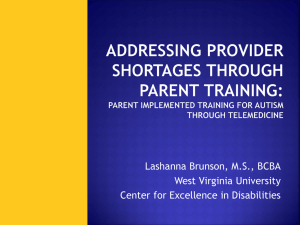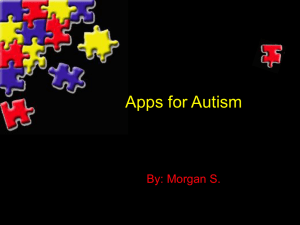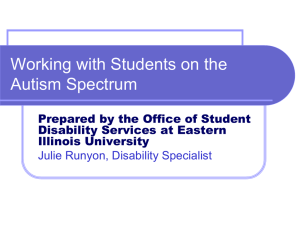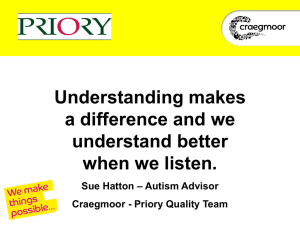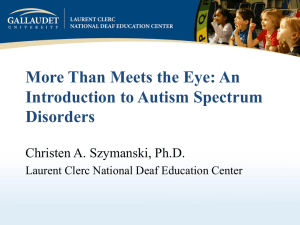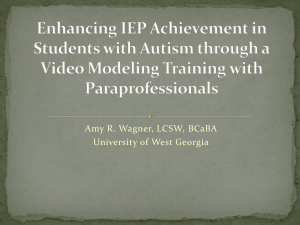PowerPoint PresentationTime Between Start of Problem Behavior 1
advertisement
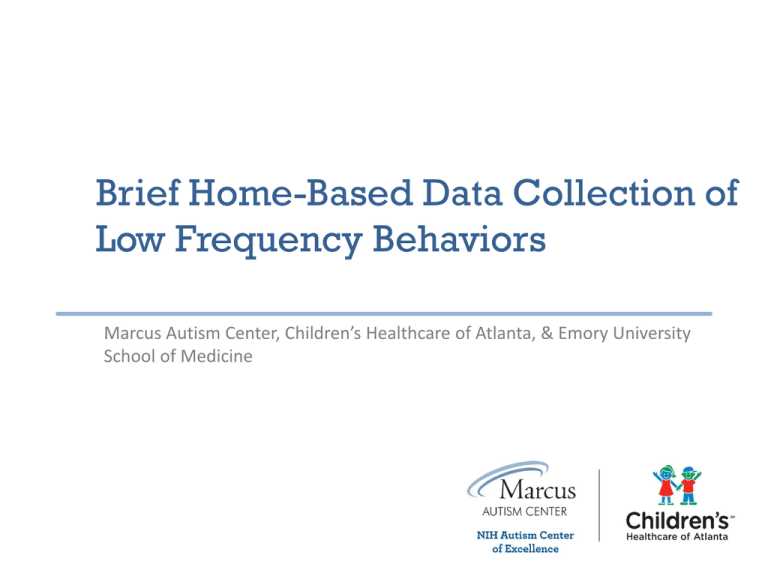
Brief Home-Based Data Collection of Low Frequency Behaviors Marcus Autism Center, Children’s Healthcare of Atlanta, & Emory University School of Medicine Data-based Decision Making • Data-based decision making is common place in positive behavioral interventions and is crucial to treatment session (Sugai et al., 2000) • Data guides – Treatment selection – Treatment modification – Ability to use the least intrusive intervention Marcus Autism Center Data Collection Challenges • Getting a representative sample – Deciding on the best time to observe – Identifying which behaviors will be measured – What to do when problem behavior is not observed or observed inconsistently Resources Representative Data Marcus Autism Center Low-Frequency High-Intensity (LFHI) Problem Behavior • These challenges are especially difficult for LFHI problem behavior • Low Frequency – Problem behavior that does not occur every day – Elevated rates of problem behavior in a cyclical manner • High Intensity – Safety risk to self or others – Damage to property Marcus Autism Center Data collection of LFHI behaviors • Problematic with typical ways of depicting data – Multiple zero points – Difficulty obtaining stability • Requires additional resources – Missing one instance can have crucial effects on data – Length of time to demonstrate results of treatment Marcus Autism Center LFHI in the literature • It is difficult to collect data for LFHI problem behavior – Few studies have studied this • One of the more comprehensive studies on this topic targeted running away behavior of children in foster care – Might be generalized to problem behavior in a home or classroom setting – Witherup, Vollmer, Van Camp, Goh, Borrero, & Mayfield (2008) Marcus Autism Center Witherup et al. (2008) • Participants – 84 children in foster care settings – All engaged in at least one episode of running away within a 3-year time frame • Data collection – Data collected from Department of Children and Families – Documented the date the run started and the date the run ended – Documented anytime the child was in a “lockdown” facility Witherup, Vollmer, Van Camp, Goh, Borrero, & Mayfield (2008) Marcus Autism Center Witherup et al. (2008) • Interval Data Collection – Looks at behavior aggregated across a period of time – Example: • Number per minute/day/month • Total number of minutes/hours/days • Average per minute/hour/day • Episode Data Collection – Looks at each episode of behavior individually – Example: • Intensity of a single incident • Frequency of problem behavior in a single instance • Percent correct on a single test Marcus Autism Center Witherup et al. (2008) • Interval-based measures: 1. Number of runs 2. Proportion of opportunity days initiating a run 3. Number of days spent on the run 4. Proportion of opportunity days spent on the run Marcus Autism Center Witherup et al. (2008) • Interval-based measures: 1. Number of runs – Example: • 2 runs across 30 days • Number of days spent on the run = 4 days • Number of days spent in lockdown = 10 days Marcus Autism Center Witherup et al. (2008) • Interval-based measures: 2. Proportion of opportunity days when a run started Number of runs = Days not in lock down and not already on the run – Example: • 2 runs across 30 days • Number of days spent on the run = 4 days • Number of days spent in lockdown = 10 days = 2 30−4−10 = 2 26 = .077 Marcus Autism Center Witherup et al. (2008) • Interval-based measures: 3. Number of days spent on the run – Example: • 2 runs across 30 days • Number of days spent on the run = 4 days • Number of days spent in lockdown = 10 days Marcus Autism Center Witherup et al. (2008) • Interval-based measures: 4. Proportion of opportunity days spent on the run Days spent on the run = Days not in lock down – Example: • 2 runs across 30 days • Number of days spent on the run = 4 days • Number of days spent in lockdown = 10 days = 4 30−10 = 4 20 = .20 Marcus Autism Center Interval Measures Graphed Marcus Autism Center Witherup et al. (2008) • Episode-Based Measures 1. Run duration 2. Time between episodes (episode inter response time) 3. Time between initiation of runs (initiation inter response time) Marcus Autism Center Witherup et al. (2008) • Episode-based measures: 1. Run Duration – Example: • 2 runs across 30 days • Run 1 started on day 4 and lasted 3 days • Run 2 started on day 25 and lasted 1 day Marcus Autism Center Witherup et al. (2008) • Episode-based measures: 2. Time between episodes – Example: • 2 runs across 30 days • Run 1 started on day 4 and lasted 3 days • Run 2 started on day 25 and lasted 1 day = start day of run 2 − end day of run 1 = 25 − 4 + 3 = 25 − 7 = 18 Marcus Autism Center Witherup et al. (2008) • Episode-based measures: 3. Time between initiation of run – Example: • 2 runs across 30 days • Run 1 started on day 4 and lasted 3 days • Run 2 started on day 25 and lasted 1 day = start day of run 2 − start day of run 1 = 25 − 4 = 21 Marcus Autism Center Episode Measures Graphed Marcus Autism Center Translating to Problem Behavior • Episode of running away could be analogous to a burst or episode of problem behavior – Number of runs = Number of bursts – Time between runs = Time from the end of one burst of problem behavior to the start of the next – Duration of run = Duration of problem behavior – Opportunity time = Days child is with the data collector (e.g., caregiver or teacher) and is not already engaging in problem behavior Marcus Autism Center Application to Clinical Practice • Determine which measurements can be derived from typical data-collection methods – Antecedent-behavior-consequence – Interview (anecdotal) data • Determine the feasibility of a new measurement system to acquire all necessary data for interval and episode based measures • Consider the balance between resources required and information obtained from each method Marcus Autism Center BBI Program • Brief behavior intervention (BBI) program through the Marcus Autism Center • Brief Behavior Intervention Program – Weekly 2-hour appointments – All appointments done in the home or community – One BCBA level therapist and caregiver present at all appointments – Parents are required to take data and practice treatment components between sessions Marcus Autism Center Initial Data Collection in BBI • Data on problem behavior is collected by the parents for the first for 14 days to establish a baseline • Types of data-collection methods – Antecedent-behavior-consequence data Standard – Interview – Low Frequency High Intensity (LFHI) Incident data Marcus Autism Center Method: ABC Data-collection • 10-15 minute didactic training with caregiver • Caregiver instructed to complete the form following each instance of problem behavior Marcus Autism Center Method: ABC Data Sheet Marcus Autism Center Method: Interview • No didactic required • Clinician asks the caregiver a variety of questions and records answer • Clinician can provide follow-up questions to clarify ambiguous responding • Completed at every appointment (no data-collection between appointments) Marcus Autism Center Method: Interview HOW MANY INSTANCES OF PROBLEM BEHAVIOR (OR BURSTS OF PROBLEM BEHAVIOR) OCCURRED? HOW SEVERE WAS THE PROBLEM BEHAVIOR? ANYTHING ELSE THAT YOU WOULD LIKE TO TELL ME ABOUT THE PROBLEM BEHAVIOR OVER THE PAST WEEK? Marcus Autism Center Method: LFHI • 10-15 minute didactic training with caregiver • Caregiver instructed to complete the form following each high intensity instance of problem behavior • Record the time of day that the caregiver is with the client Marcus Autism Center Method: LFHI In the table below, record each burst of problem behavior, mark yes or no to indicate the amount of damage caused by the burst, and rate the intensity of the problem behavior using the scale below (complete an additional data sheet if more spaces is needed). 1 = Less severe than your child’s normal burst of problem behavior 2 = About the same as your child’s normal burst of problem behavior 3 = More severe than your child’s normal burst of problem behavior Date 12/ 4 When did problem behavior start? When did problem behavior end? Did any injury occur? Did harm to the environment occur? Did the burst significantly interrupt your family’s schedule? 9:45 9:55 Y / N Y / N Y / N 1 2 3 Y / N Y / N Y / N 1 2 3 Y / N Y / N Y / N 1 2 3 Y / N Y / N Y / N 1 2 3 Y / N Y / N Y / N 1 2 3 How severe was this burst? Primary behavior(s): Aggressive, Disruption, Yelling Primary behavior(s): Primary behavior(s): Primary behavior(s): Primary behavior(s): Monday Date:__12/4___ In the table below, list the time that you were NOT with your child this week (e.g., school, babysitter). Tuesday Wednesday Thursday Friday Saturday Date:_______ Date:_______ Date:_______ Date:_______ Date:_______ Sunday Date:_______ 7:30 am – 2:30 pm Marcus Autism Center Results: ABC Data • Data is obtained on frequency • No data collected on opportunity time • Methods that can be calculated – Number of bursts – Time between starts of problem behavior • Case Example – 4yo male – Autism spectrum disorder – Problem behavior: aggression, disruptive behavior, yelling Marcus Autism Center ABC Data Representation 90 Hours Between Start of Problem Behavior Number of Bursts of Problem Behavior 4.5 4 3.5 3 2.5 2 1.5 1 0.5 0 0 2 4 6 2-Day Data Collection Period 8 80 70 60 50 40 30 20 10 0 0 2 4 6 8 10 Burst of Problem Behavior Marcus Autism Center 12 14 Results: Interview • Data is obtained on estimated frequency over the course of a week • No data collected on opportunity time or specific number or duration of bursts • Methods that can be calculated – Approximate number of bursts per week Marcus Autism Center Results: LFHI Incident Recording • Data is obtained on frequency and duration of each burst • Information gathered to calculate opportunity time • Methods that can be calculated – All incident and episode approaches • Case example: – 19yo female – Autism spectrum disorder – Problem behavior: self-injury, aggression, disruptive behavior, dropping, yelling Marcus Autism Center LFHI Data Representation: Incident 5 Time spent engaging in problem behavior (Hours) Number of Bursts of Problem Behavior 2.5 2 1.5 1 0.5 0 4.5 4 3.5 3 2.5 2 1.5 1 0.5 0 0 2 4 6 2-Day Data Collection Period 8 0 2 4 6 2-Day Data Collection Period Marcus Autism Center 8 LFHI Data Representation: Episode 160 Hours Between Start of Problem Behavior Duration of Burst (Hours) 3.5 3 2.5 2 1.5 1 0.5 0 0 1 2 3 4 Burst of Problem Behavior 5 6 140 120 100 80 60 40 20 0 0 1 2 3 4 Burst of Problem Behavior Marcus Autism Center 5 6 Results Summary: Incident recording Data ABC LFHI Interview Number of Bursts Yes Yes Approximate Proportion of opportunity time with bursts No Yes No Approximate Yes No No Yes No Time spent engaging in problem behavior Proportion of opporunity time spent engaging in problem behavior Marcus Autism Center Results Summary: Episode recording Data ABC LFHI Interview Duration of bursts Approximate Yes No Time between bursts of problem behavior Approximate Yes No Yes Yes No Time between start of problem behavior Marcus Autism Center Resource Commitment • Using an incident recording system allows for the most information in regards to the number of episodes, duration of episodes, and time between episodes – Approximately the same amount of response effort as ABC data collection • Interview data provides the least amount of information – Least amount of response effort • Measures of severity can be captured in both ABC and LFHI data collection Marcus Autism Center Considering Additional Information • ABC provides additional information regarding the potential function of problem behavior • Important to consider the goal of collecting data – Establish a baseline or evaluate a treatment’s effectiveness – Gather information to determine resources required – Determine the function of problem behavior to create a treatment plan • Available resources – If ABC and LFHI cannot be completed, interview might be better Marcus Autism Center Clinical Implications • Selecting method of data-collection – Incident recording if the primary goal is to only collect baseline rates • Provides the most accurate and in-depth information about rates, duration, and severity – ABC if the primary goal is to determine function • Providing the most information about the antecedents and consequences of the problem behavior – Interview if the other methods are to cumbersome Marcus Autism Center Future Research • Determine the sensitivity to detect treatment effects with the different methods • Evaluate the effectiveness of these tools over a longer baseline period – Start while on wait-list • Develop a screening tool to identify available parental resources – Time – Cognitive capacity (e.g., memory) Marcus Autism Center Questions?

